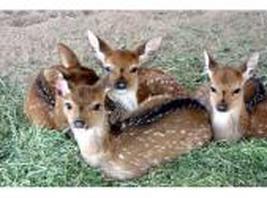White Tail Deer
.

Type: Mammal
Diet: Herbivore
Average lifespan in captivity: 6 to 14 years
Size: 6 to 7.75 ft (1.8 to 2.4 m)
Weight: 110 to 300 lbs (50 to 136 kg)
Did you know? "White-tailed” refers to the
white underside of the deer’s tail, which it
displays and wags when it senses danger.
Diet: Herbivore
Average lifespan in captivity: 6 to 14 years
Size: 6 to 7.75 ft (1.8 to 2.4 m)
Weight: 110 to 300 lbs (50 to 136 kg)
Did you know? "White-tailed” refers to the
white underside of the deer’s tail, which it
displays and wags when it senses danger.
Even though all of us that are around the lake see many deer we are still always in awe of the beautiful animals. They amble quietly through the woods minding their own business.
Young deer are known as fawns are reddish – brown with white spots which help them blend into the forest. Fawns frolic almost like puppies leaping and playing tag with each other.
Female deer are called does. They give birth to one to three young at a time. The gestation period is seven months and the fawns arrive around May or June.
Male deer are called bucks. They are easy to spot with the growth of their antlers which they have summer and fall. Their antlers grow annually and fall off in the winter. During mating season bucks fight over their territory with sparring matches using their antlers.
Adult male and female deer are reddish-brown in the summer and fade to a dull grayish-brown in the winter. Deer are herbivores (feeding on plants). They can digest a varied diet including leaves, twigs, fruits, nuts, grass, corn, alfalfa and even lichens and other fungi.
Feeding time is generally at dawn and dusk .Occasionally you will see them in the daytime but they are primarily nocturnal.
In the wild the young are particularly preyed upon by coyotes, bobcats, and mountain lions. With speeds up to 30 mph (48 kilometers) and the agility of leaping 10 feet high and as far as 30 feet they generally have a good chance of outrunning their predators.
Young deer are known as fawns are reddish – brown with white spots which help them blend into the forest. Fawns frolic almost like puppies leaping and playing tag with each other.
Female deer are called does. They give birth to one to three young at a time. The gestation period is seven months and the fawns arrive around May or June.
Male deer are called bucks. They are easy to spot with the growth of their antlers which they have summer and fall. Their antlers grow annually and fall off in the winter. During mating season bucks fight over their territory with sparring matches using their antlers.
Adult male and female deer are reddish-brown in the summer and fade to a dull grayish-brown in the winter. Deer are herbivores (feeding on plants). They can digest a varied diet including leaves, twigs, fruits, nuts, grass, corn, alfalfa and even lichens and other fungi.
Feeding time is generally at dawn and dusk .Occasionally you will see them in the daytime but they are primarily nocturnal.
In the wild the young are particularly preyed upon by coyotes, bobcats, and mountain lions. With speeds up to 30 mph (48 kilometers) and the agility of leaping 10 feet high and as far as 30 feet they generally have a good chance of outrunning their predators.
